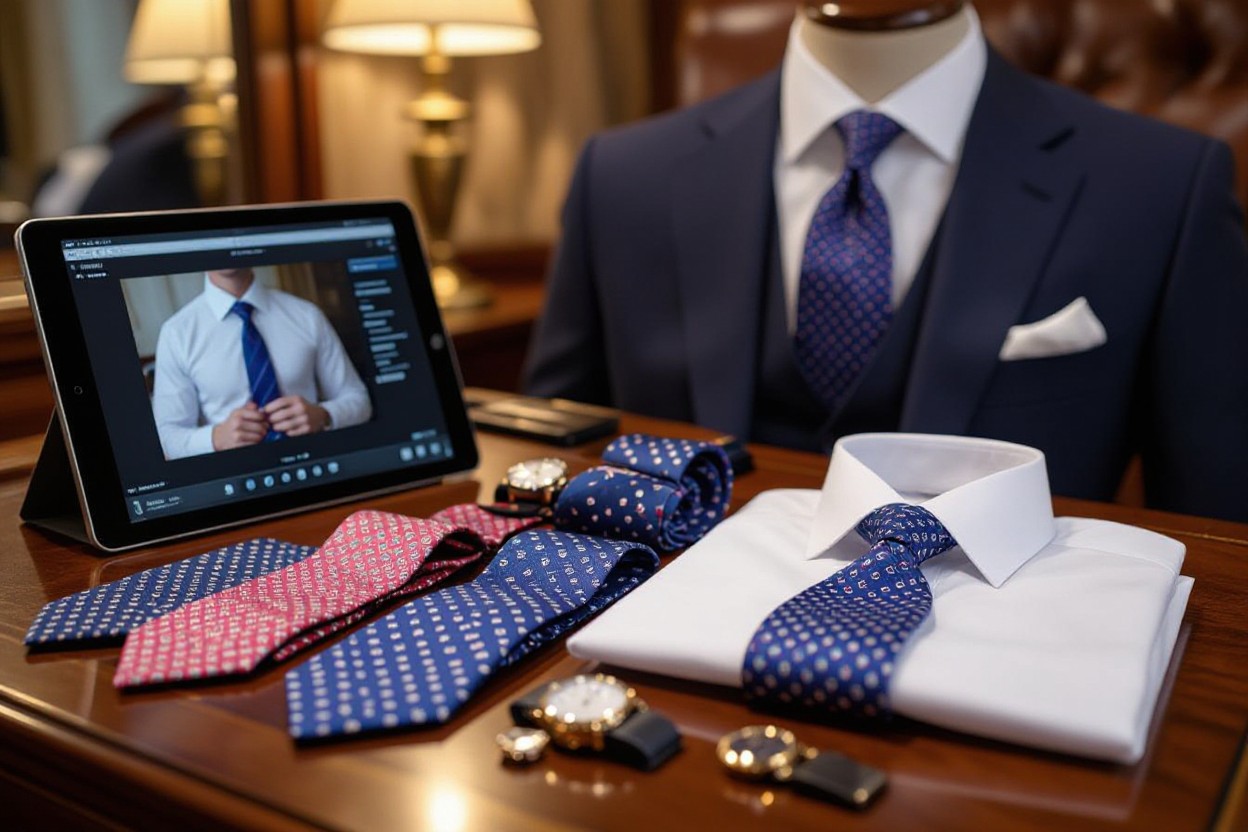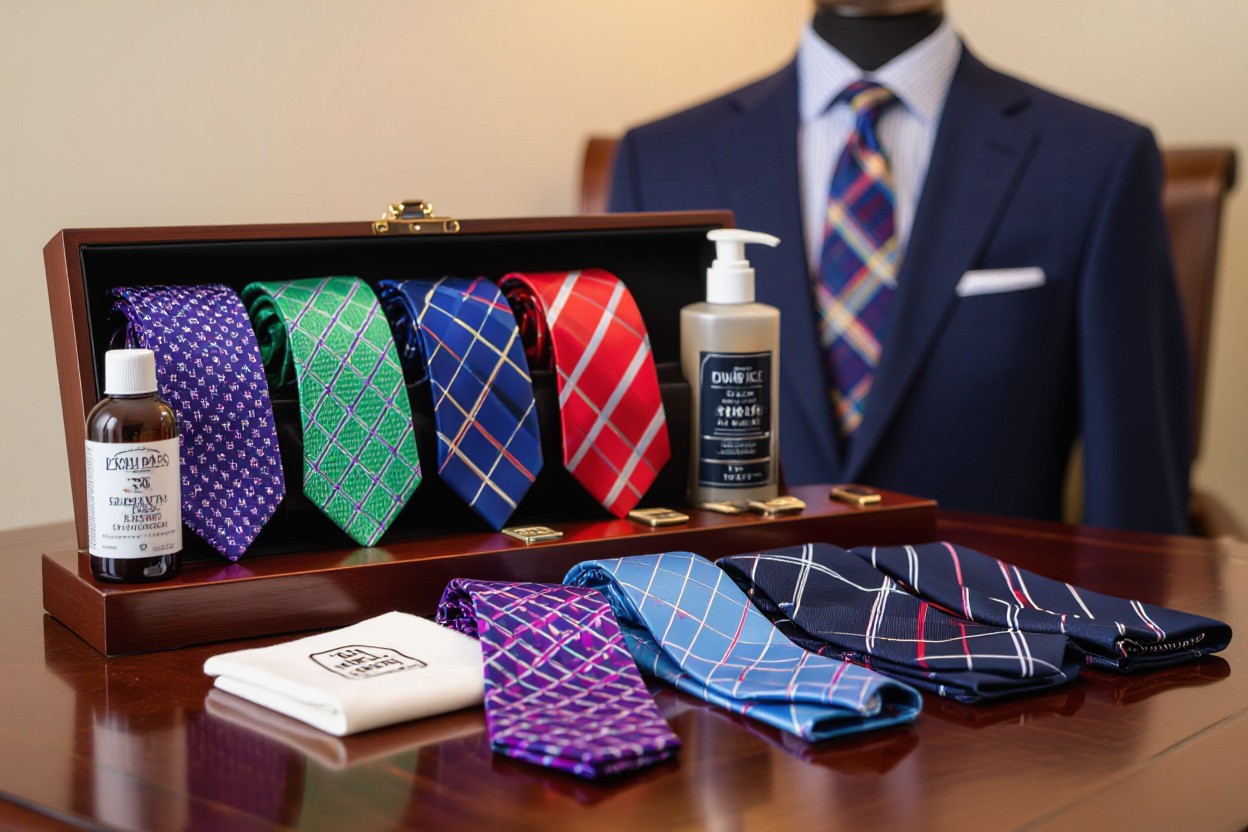Tie tying may seem straightforward, but mastering the skill can significantly enhance your appearance and confidence. In this guide, I will walk you through easy-to-follow steps to tie a tie perfectly for any event, from business meetings to formal celebrations. You’ll learn the differences between popular knots and how to choose the right one based on your collar style and tie fabric. By the end, you’ll have the proficiency to elevate your look with a neat, secure tie knot that lasts all day without discomfort or slipping.
The Anatomy of a Tie: Know Your Components
Understanding the basic parts of a tie helps you grasp how different knots work and how the tie sits when worn. A typical tie consists of the blade—the wide end that faces outward—the tail, which is the narrow end that tucks behind, and the keeper loop, a small fabric loop on the underside that holds the tail in place. The interlining inside provides structure and weight, affecting how the knot forms and how the tie drapes. Recognizing these components allows you to handle and maintain your tie better.
Types of Ties: Styles and Contexts
Tie styles vary widely, each suited for different occasions and personal styles. The classic necktie is versatile and perfect for business or formal settings. For casual or trendy looks, skinny ties offer a modern appeal. Bow ties elevate black-tie events and add flair. There are also knitted ties for a textured, relaxed vibe. Matching the tie type to your outfit context enhances your overall appearance. Recognizing these styles helps you select the right tie for any event.
| Component | Function |
|---|---|
| Blade | The visibly wide front part of the tie, creating the statement and length. |
| Tail | The narrow end tucked behind and secured by the keeper loop or tie knot. |
| Keeper Loop | A fabric loop on the back to hold the tail in place and maintain neatness. |
| Interlining | Internal layer that adds weight and structure for proper knot formation. |
| Tip | The end edge of both blade and tail, often stitched or fused for durability. |
Materials Matter: Choosing the Right Fabric
Fabric choice dramatically impacts the tie’s look and knot behavior. Silk ties offer sheen and smooth texture, ideal for formal settings. For everyday wear, wool and cotton ties provide interesting textures and less shine, lending to a relaxed aesthetic. Synthetic blends can mimic silk with greater durability and stain resistance. Knowing fabric types guides your choice based on occasion and personal comfort. Recognizing the material makes selecting and caring for your ties straightforward.
The fiber composition affects how a tie holds a knot and how it feels against your shirt collar. Silk’s natural elasticity and luster give knots a crisp definition, perfect for weddings or boardrooms. Wool ties, thicker and matte, suit fall and winter wardrobes, pairing well with tweeds and heavier suits. Cotton ties work well in spring and summer, maintaining breathability. Synthetic fabrics like polyester are budget-friendly but might feel less luxurious. Considering these properties helps tailor your tie selections to the season and event.

Mastering the Basics: Essential Knot Techniques
Getting comfortable with a few fundamental knots drastically improves your tie-wearing confidence. Each knot offers a different look and fit depending on the collar style and occasion. I recommend starting with knots that balance simplicity and elegance, allowing you to refine your technique effortlessly. Understanding how the fabric folds and the final knot’s proportions ensures your tie complements rather than overwhelms your outfit. Practicing these knots repeatedly will soon make the process feel intuitive, saving you time and delivering a polished appearance every time.
The Classic Four-in-Hand: Your Go-To Knot
The Four-in-Hand knot remains a favorite because of its simplicity and versatility. It produces a narrow, slightly asymmetrical knot that works well with most collar types, especially button-down and spread collars. This knot shines in both casual and formal settings, making it a dependable choice when you’re short on time but want a neat appearance. Its compact size suits ties made of thicker fabrics, avoiding an overly bulky look. Perfecting this knot offers a reliable fallback for daily dressing without sacrificing style.
The Versatile Windsor: Making a Statement
The Windsor knot delivers a bold, symmetrically triangular shape that commands attention and works especially well with wide collar spreads. It uses more tie length than the Four-in-Hand, so it fits best with longer ties or shorter necks to avoid excess fabric. This knot creates a strong focal point for presentations, interviews, or formal events where you want to project confidence and professionalism. Its full, balanced look makes even simple tie patterns appear more structured and impactful.
Delving deeper into the Windsor, I find that mastering the subtle tension in each wrap ensures the knot stays crisp throughout the day. The triple wrap required can initially feel complex, but dividing the steps slowly builds muscle memory. It’s fascinating how slight adjustments in tightness alter the knot’s size and shape, allowing customization based on tie thickness and collar formality. Using this knot, I often match my shirt’s collar style precisely, producing a harmonious ensemble that elevates my overall look without seeming overdone.

Crafting the Perfect Look: Tailoring Your Tie to the Occasion
Matching your tie to the event transforms your entire outfit. For instance, a silk tie with a subtle sheen elevates your presence at formal gatherings, while a knit tie with vibrant patterns injects personality into casual settings. I always consider the dress code, lighting, and company size to decide whether the tie should command attention or subtly complement my ensemble. This approach lets you effortlessly blend in or stand out, depending on the setting, ensuring your look is polished and purpose-driven.
Formal Events: Tying for Weddings and Professional Settings
For weddings and professional settings, I favor a classic knot like the Half Windsor, which offers symmetry and balance suitable for collared shirts and tailored suits. Dark-colored ties—navy, charcoal, or burgundy—with minimal patterns convey professionalism and elegance. Opting for silk, the traditional material, adds a refined texture. I also ensure the tie length reaches the beltline exactly, as anything too short or long can distract from the outfit’s harmony and diminish the polished impact.
Casual Outings: When and How to Dress Down
Casual outings give you room to experiment with textures, colors, and knots. I usually choose cotton or wool ties because they absorb light differently, lending a relaxed vibe. Patterns like checks, stripes, or subtle florals work great. Looser knots like the Four-in-Hand create a laid-back look, and pairing ties with open-collar shirts or denim blazers softens the formality, making the overall style inviting yet intentional.
Exploring casual ties further, many designers incorporate seasonal elements—think earthy autumn hues or pastel spring tones—which resonate well with the informal atmosphere. It’s also worth trying out less conventional knots or double windsor when you want a playful twist without veering into sloppy territory. In settings like brunches or casual Fridays, this approach lets you maintain neatness while embracing an effortless style that reflects your personality.

Tie Care and Maintenance: Keeping Your Look Polished
Maintaining your tie extends its lifespan and preserves that sharp, fresh appearance. Once you master the perfect knot, it’s equally vital to care for your ties by proper handling, storing, and cleaning. Regularly inspecting your ties for loose threads or wrinkles and addressing them promptly can prevent permanent damage. Gentle care practices, rather than harsh treatments, maintain fabric integrity and color vibrancy. The right approach to tie care ensures that each occasion you wear it, your tie remains a confident style statement.
Storing Your Ties: Best Practices
Storing ties correctly prevents wrinkles and fabric distortion, which can undermine your carefully tied knot. Hanging ties flat on a tie rack or draping them over a hanger helps maintain their shape and airflow, reducing the buildup of odors. Rolling ties loosely and depositing them in a drawer works well for delicate silks or when space is limited. The focus should be on avoiding tight knots or folds while they rest, so your next wear showcases a crisp, polished look.
Cleaning and Repairing: Tips for Longevity
Spot cleaning stains immediately with a damp cloth or specialized stain remover protects fabric without the risk of damaging delicate fibers. Dry cleaning remains the safest option for silk and other high-end materials, used sparingly to prevent wear. Gentle stitching repairs on small tears or loose threads can save an otherwise costly tie. The key is to treat each tie with care, preserving its fabric and design so you enjoy it across many wears.
Expanding on cleaning and repairing, it’s important to be gentle with your ties during care. Use mild detergents and avoid machine washing, which often causes fabric shrinkage and color fading. For stubborn stains, a professional dry cleaner experienced with ties can work wonders without compromising fabric quality. If you notice loose stitching, repairing these small issues promptly prevents them from becoming noticeable tears. Keeping an eye on the condition of your ties and addressing any mishaps early ensures their durability and polished appearance. The consistent care you give your ties pays off in long-term style and savings.
- Spot cleaning avoids fabric damage by treating stains promptly
- Professional dry cleaning preserves silk and delicate materials best
- Prompt stitching repairs prevent small issues from worsening
- Avoid machine washing to prevent shrinkage and color loss
- The long-lasting look of your tie depends on gentle, consistent care
Troubleshooting Common Tie Issues: Avoiding Fashion Faux Pas
Even with the best-laid plans, ties can misbehave. I’ve seen perfectly tied knots shift, collars gape oddly, or the tail end sneak out, undermining a sharp look. Tackling these hiccups early keeps your ensemble neat and polished. Adjusting the knot’s position and tightening with subtle pulls often restores balance, while using simple tools like tie bars or discreet stitches prevents slippage. Stay vigilant about these small fixes to maintain that confident appearance throughout the day.
Fixing a Misaligned Knot: Quick Solutions
If your tie knot leans off-center or looks uneven, I suggest gently loosening it, realigning the narrower end beneath the wide front, then re-tightening with steady, even pressure. Sometimes a slight tilt to the collar or repositioning the tie loop inside the shirt can recalibrate the symmetry. Avoid forceful pulls that risk damaging fabric; instead, work patiently until the knot sits firmly and straight on your collar.
Dealing with Slippage: Securing Your Tie
Slippage causes your tie to drop or shift, breaking the polished effect. I often use a tie clip or bar placed between the third and fourth shirt buttons, which anchors the tie securely. Alternatively, a simple stitch on the back stabilizes the narrow end against the shirt. Textures matter here: silk ties slip more than wool or cotton, so choosing the right accessory or fastening method can prevent constant adjustments.
Tie slippage not only disrupts your outfit’s neatness but can also signal inattentiveness. Incorporating a tie bar isn’t just decorative—it serves a vital practical role by keeping the tie aligned with your shirt placket, especially during active moments or long meetings. For silk ties with flair yet tendency to slide, I recommend a discreet double-sided tape or a fabric-safe adhesive strip inside the knot, which provides extra grip without altering the appearance. This subtle reinforcement ensures your tie stays put, preserving your confident, well-groomed aesthetic throughout the day.
Final Words
As a reminder, mastering how to tie a tie is a valuable skill that enhances your appearance for any event. I encourage you to practice the steps I’ve shared to confidently create neat, professional knots. Whether for work, a wedding, or a formal dinner, your ability to tie a perfect tie reflects attention to detail and personal style. Take your time, be patient, and soon you’ll find the process straightforward and even enjoyable. Your well-tied tie will surely make a positive impression every time you wear it.





Leave a comment